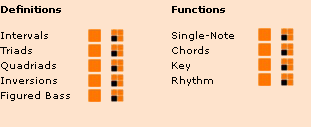


The Elements of Harmony > Intervals (basic) > Interval Name Chart


Interval Names
The chromatic scale is a sequence of 12 notes within the interval of an octave. As measured from the root, or bottom note of this scale, the names of the twelve intervals between each of the twelve notes and the root are:
root - 2nd note: minor 2nd
root - 3rd note: major 2nd
root - 4th note: minor 3rd
root - 5th note: major 3rd
root - 6th note: perfect fourth
root - 7th note: augmented 4th (or diminished 5th)
root - 8th note: perfect 5th
root - 9th note: minor 6th
root - 10th note: major 6th
root - 11th note: minor 7th
root - 12th note: major 7th
root - 13th note: octave
Sometimes, a perfect or minor interval may be decreased by a half step. On the staff, this can be achieved by simply placing the (flat) symbol in front of the top note (or by placing the
![]() (sharp) symbol in front of the bottom note). Since the note position on the staff remains the same, but is merely preceded by an extra flat or sharp symbol, the name of the new interval changes from "perfect" (or "minor") to "diminished".
(sharp) symbol in front of the bottom note). Since the note position on the staff remains the same, but is merely preceded by an extra flat or sharp symbol, the name of the new interval changes from "perfect" (or "minor") to "diminished".
A similar procedure applies to a perfect or major interval. The interval may be increased by a half step, by simply placing the ![]() symbol in front of the top note (or by placing the
symbol in front of the top note (or by placing the symbol in front of the bottom note). In this case the interval name changes from "perfect" (or "major") to "augmented".
The Elements of Harmony | Baroque Harmony | 4-Part Jazz Harmony | Harmonic Sequences Archive | Percussion | Pythagoras | 4-Part Score Editor | Discussion Forum